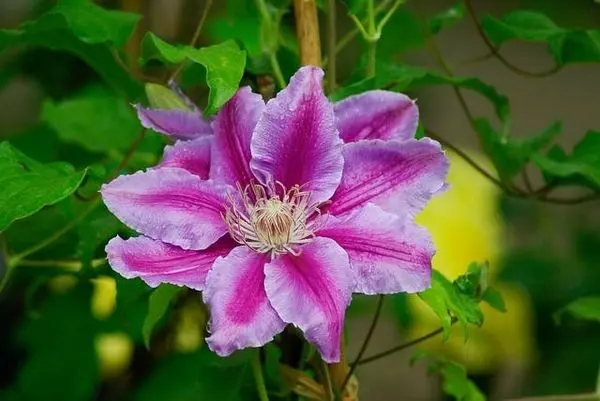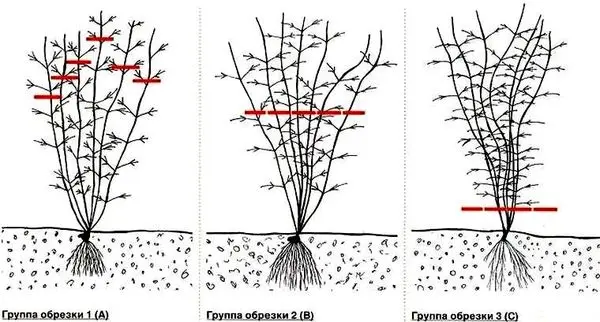Contents
Luxuriously blooming clematis, mounted on a trellis, becomes a wonderful decoration of any yard. In order for flowering to please the eye every year, you need to know how to prepare clematis for winter. Proper shelter and easy wintering will ensure a start next spring.
Autumn care
Most perennials need a series of activities in the fall to end the growing season and start preparing for winter. So, since August, nitrogen has been excluded from top dressing, otherwise the plants, instead of ripening existing shoots, will begin to grow new ones.

In autumn, the plants must be watered abundantly, and if there is no rain, then even twice. Then the clematis are fed, removed from the supports, cut and insulated. Before winter, the trunk circle is treated with fungicides to prevent fungal diseases next year.
In the ground under the bushes, the larvae of parasites and pests, the causative agents of all kinds of diseases, usually try to overwinter. In order not to leave them a chance, it is advisable to treat the ground and the lower part of the shoots with iron sulfate (2%) or Bordeaux liquid (1%).
Trimming rules
There are several types of pruning: shaping, rejuvenating and sanitary. Autumn pruning combines them all and helps shelter the plant for the winter. The best time for her comes 2-3 weeks before frost. In different areas, it is held from late October to mid-November.
Young plants of the first year of life are cut at a height of 20–30 cm, leaving only three healthy buds, regardless of species or variety. This allows not only to properly cover the still weak plant, but stimulates the growth of lateral shoots, due to which a lush bush will grow next year.
But adult clematis are pruned, depending on which shoots flowers form on. On this basis, all varieties are traditionally divided into 3 groups:
- The first includes varieties that form flowers on last year’s shoots, for example, Biryuzinka, Hegley Hybrid, Cardinal Rouge, etc. Only damaged, diseased or very weak shoots are cut from these plants, and the rest are shortened to 1,5 m.
- Varieties Ball of Flowers, Minister, President, Dawn, Fair Rosamund bloom twice – since the beginning of summer on the shoots of last year, and since July – on the shoots of this year. Such varieties belong to the second group, they are recommended to be cut at a level of 1–1,3 m from the ground. But experienced flower growers advise cutting all healthy shoots through one: shorten one to 1,2 m, and the other to 20-30 cm, so that 2-3 buds remain on it. After such pruning, the flowering of the first and second waves will occur at approximately the same height level, which will form a beautiful, neat bush.
- The third group united clematis that bloom only on the shoots of the current year. These are the Jacquemann, Integrifolia, Vititsella groups. Depending on the variety, they are cut in two ways – at a height of 20–30 cm, leaving up to 4 pairs of buds, or almost at the very ground, leaving only 2 buds.

Subsequent top dressing
A good preparation for cold weather is top dressing with mineral fertilizers containing potassium and phosphorus. Fertilizers are scattered over the entire area of the near-stem circle, slightly embedded in the ground, or dissolved with water and poured into a groove made along the perimeter of the near-stem circle. Wood ash scattered under plants has proven itself well, which both fertilizes them and repels pests.
Clematis does not like acidic soil, so pine needles and sawdust of coniferous trees used for insulation (at the same time as repelling rodents) must be removed in the spring when it is time to dismantle the shelter.
Video “Preparing clematis for winter”
From this video you will learn how to properly prepare clematis for the winter period.
Variety of shelters
The shelter of different clematis for the winter should differ depending on their frost resistance, degree of pruning, region of growth. There are frost-resistant varieties, and there are those that are afraid of even a ten-degree frost. But worse than the most severe frost, water can destroy a plant: flooding of the roots during a thaw will bring inevitable death to the plant with the return of frost. Therefore, to prepare a bush for wintering correctly means to fill a hill at least 30 cm so that it does not end up in a hollow in any case.
Bushes spud with earth mixed with dry peat, humus, wood ash. Young clematis should survive their first winter well wrapped, regardless of the degree of frost resistance of the variety.
Of course, it is easier to cover short, heavily cut bushes. They are highly spudded, wrapped with lutrasil or other non-woven material, a frame is built over them, covered with fallen leaves or covered with spruce branches.
By the same principle, plants with long shoots are closed, only they need to be covered with a hard roof from above so that heavy snow does not roll down the entire shelter, depriving it of ventilation. After pruning at the desired height, carefully untie the wires and ropes with which the shoots were tied to the trellis, cut off the leaves that are hooked on the support for stability with scissors.
After that, the plant is wrapped with lutrasil, laid horizontally (having previously spudded the roots, covering the near-stem circle), but not on the ground, but on a pillow, the role of which can be played by a board, polystyrene, spruce branches, a cut part of the same bush. It is best to build a frame, cover it with insulating material, put a hard roof on top, and fill the space inside with litter, sawdust or pine needles.
Clematis leaves do not crumble, but cut them off in the spring. Then they carry out sanitary pruning, unravel the shoots, attach them to the trellis only on one side, otherwise they will braid it too much and it will be impossible to remove it in the fall. It is advisable to place traps for rodents near the plant or scare them away, for example, mice do not like sharp pine needles.
Landmark for geographic areas
The degree of insulation should correspond to the severity of the winter and the climate. So, in the Moscow region and throughout the middle lane, winters are not too severe, but sharp fluctuations in temperature threaten to destroy plants if they become wet during a thaw or water collects in the shelter. Therefore, flower growers have to ventilate clematis, and cover them so that they can be easily opened or wrapped again.
The Volga region is characterized by high humidity. Here, plants need to be highly hilled, and whole hills should be poured at the bases. Some summer residents cover the ground above the roots with polyethylene, and earth, peat, and sawdust are piled on it.
The harsh conditions of the Urals and Siberia require more thorough insulation. The abundance of snow will protect from frost, but it is necessary to make a frame and a rigid roof so that it does not sag under the weight of snow. Such conditions require the cultivation of early varieties, since winter comes quickly, and the shoots of late-flowering clematis do not have time to ripen before frost, which means they may not survive until spring with any shelter.
It is very important not to forget about winter care: in frosts, snow should lie on covered flowers, during thaws, you need to check if water has accumulated under the plant.
If the ground under the shoots is wet, boards, slate, roofing material are placed on it – any material that will help protect the branches from moisture.









